Photos with this report (click to enlarge) | |||
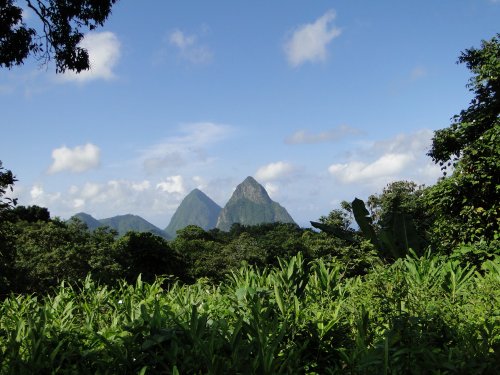 Pitons |
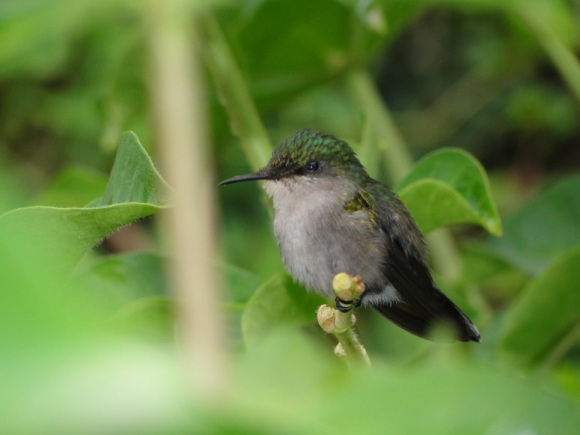 Antillean Crested Hummingbird |
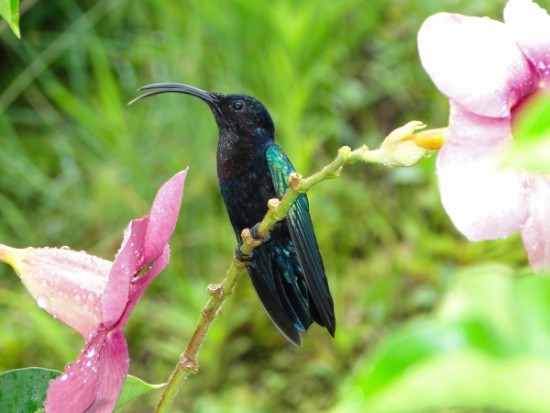 Purple-throated Carib |
|
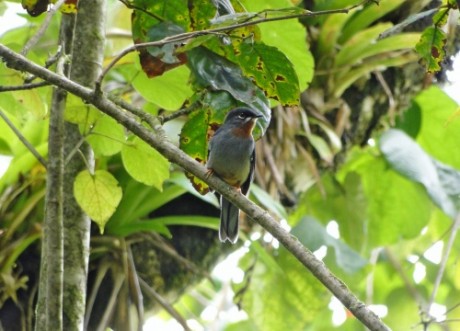 Rufous-throated Solitare |
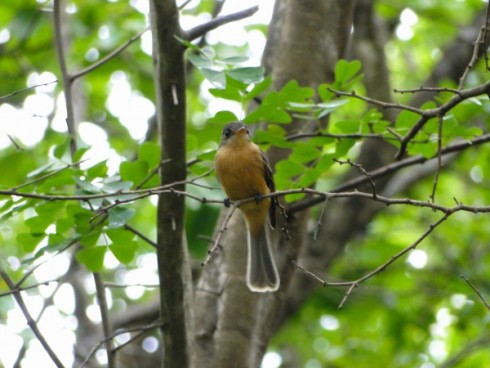 St Lucia Pewee |
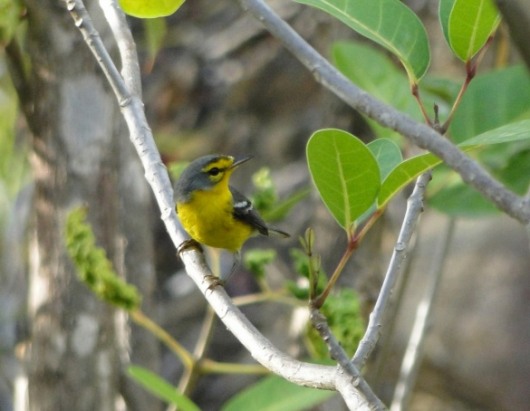 St Lucia Warbler |
|
Introduction
This brief report outlines the birding during a week’s trip from 27th August to 3rd September 2018, which I undertook with my wife, Alison Rowntree. It combined rest and relaxation with some birding focusing on finding endemics and near endemics.
We booked a package deal with Blue Bay Travel via Travelzoo and stayed all inclusive, at the Bel Jou in Castries (north-west coast). This was of good quality; more detail can be found in my review on Trip Advisor ("PlymouthPete19").
We used Adams Toussaint and his colleague Vision as bird guides (contact via toussaintadams@yahoo.com). We booked excursions for one-and-a-half days, well in advance, and this proved an excellent choice. They picked us up from our hotel and were excellent guides – punctual and great company as well as very skilled and focused on finding target species. We recommend them. Whilst it it possible to hire a car and go birding without guides, the cost is high, navigation and some road conditions could be challenging and finding certain species difficult.
St Lucia is a wonderful country to combine a relaxing holiday with some quality birding. There is great scenery and plenty to see amongst very friendly people as well as some good birds including endemics, which can be seen in a relatively short period of time.
This is an independent report, not linked to any company or third party provider.
For further information please feel free to contact me - peteraley@msn.com
The Birds
We saw 54 species during our stay including all the endemics: St Lucia Parrot, Black Finch, Pewee, Oriole and Warbler. In addition, we encountered a good range of birds which occur only on a few Caribbean islands, some just within the Lesser Antilles. It was definitely quality not quantity! More details are in the species list below.
As ever, the Fatbirder website, gives a good overview of St Lucia’s birdlife and although we had guides, I consulted a few trip reports in advance. We also invested in the International Travel Map of St Lucia, Scale 1:40,000.
We used the Helm field guide Birds of the West Indies (Rafaele, Wiley, Garrido, Keith & Rafaele, 2003) which proved adequate.
Photos, in addition to those with this report, can be found on Surfbirds (World Birding gallery).
Sites visited
Following a 5.30am pick up, the first stop on our all day trip with Adams was Praslin (Denney area on central east coast) a dry bush hotspot for endemics n.b. White-breasted Thrasher. Within minutes of arrival, Adams had dug out the Thrashers for us and after enjoying decent views of these striking two-tone birds, we continued walking into the bush. (Note: care is needed to avoid deadly Fer-de-lance snakes which live here). Some beautiful blue-grey and yellow St Lucia Warblers showed well but our search for more endemics was unsuccessful and we pressed on to the Quilesse Forest (central south).
Here after finding a colourful Antillean Euphonia beside the road, we focused on the Des Cartier Trail area which includes some really nice rain forest. This is another good area for endemics and quickly we added the rather tame St Lucia Pewee to our tally. Next, scanning trees from a vantage point, we scoped some large and noisy St Lucia Parrots, finally counting nine birds in a loose flock. Walking along a muddy track deeper into the forest, and following up calls, eventually led us to a male St Lucia Black Finch boldly proclaiming his territory. Still alert to further endemic potential, as we retuned, Adams heard a St Lucia Oriole. After a short search, there it was – a splash of bright orange in the tree top and our only sighting of the species during our stay. A few Indian Mongooses were the only interesting mammal sighting of the trip.
Our final site of the day was Mamiku Gardens (near Praslin) where Adams worked tirelessly to find Bridled Quail-dove. However it was a difficult time of year to connect with this species, which proved to be the only real miss of the trip.
Our second excursion with a guide was a half day with Vision, leaving at 6am. As we passed through the Cul de Sac valley (just south of Castries) I drew attention to a Glossy Ibis. Vision slammed on the brakes and after a short search we found two of them amongst the long grass - a vagrant to St Lucia and a world tick for Vision!
Continuing, we arrived in dry forest just north of Soufriere (south-west coast). Here, alert to the call as we drove along, Vision soon picked up a Lesser Antillean Flycatcher showing off its striking yellow underparts, as well as another Black Finch, this time an immature.
With persistence after stopping at a few different spots, we eventually connected with Pearly-eyed Thrasher, a much more difficult bird to see than its Scaly-breasted cousin. A brief view of Ruddy Quail-dove in the same area, was a bonus. At the first attempt, House Wren performed well showing several times at close range and all with the stunning backdrop of the Piton peaks in the distance.
After passing through the lovely fishing village of Soufriere, we drove inland, eventually following a rough track up through rain forest. Another Pearly-eyed Thrasher showed here (and Vision heard St Lucia Oriole, Antillean Euphonia and saw two St Lucia Parrots). However several stops failed to produce the hoped-for Rufous-throated Solitaire. Unperturbed, Vision parked the van and we walked along a rough damp track (inaccessible to vehicles since the 2010 hurricane) further into the forest. Here, after a bit of searching, out popped the Solitaire to give fantastic prolonged views. Wow! With deep red throat and under-tail covets, offset by dark blue uppers and neat white face markings. this bird exceeded all expectations and quickly got elevated to bird of the trip! With our birding complete, we took the opportunity to visit the nearby drive-in volcano before returning to the hotel.
In addition, we visited these sites:-
Pigeon Island (at the northern tip): an excursion put on by the hotel which gave us a couple of hours to wander around and birdwatch. We walked to the view point and along the beaches. We found a few seabirds including the only Brown Boobies of the trip, as well as a variety of land birds.
Vigie Beach (Castries): a short shuttle bus ride from our hotel. Here I walked to the lighthouse (access via Nelson Mandella Drive just up hill from the west end of the beach) and back. The bus driver said the area was safe and it afforded me a decent variety of birds including the only Short-tailed Swifts of the trip.
We also recorded the following in, from or immediately outside the Bel Jou hotel: Broad-winged Hawk, American Kestrel, Lesser Antillean Bullfinch, Bare-eyed Robin, Scaly-naped Pigeon, Antillean Crested Hummingbird, Purple-throated Carib, Green-throated Carib, Bananaquit, Grey Kingbird, Carib Grackle, Tropical Mockingbird, Zenaida Dove, Magnificent Frigatebird, Cattle Egret, Scaly-breasted Thrasher, Black-faced Grassquit, Caribbean Elaenia, Common Ground-dove, Mangrove Cuckoo, Green Heron, Caribbean Martin, Little Blue Heron, Grey Trembler, Spotted Sandpiper, Little Blue Heron & Shiny Cowbird. Many of the birds including the Trembler were in vegetation opposite the hotel’s entrance.
Brown Booby: 15+ Pigeon Island, mainly on small island to north of promintary, although a few over the sea.
Magnificent Frigatebird: Common on the coast.
Laughing Gull: c10 in total including just south of Castries, near Praslin and Pigeon Island. Apparently lingering in greater numbers than expected for this time of year.
Royal Tern: 4 Pigeon Island & 1 near Praslin.
Common Tern: 1 near Praslin.
Cabot’s Tern: 3 Pigeon Island & 2 just south of Castries.
Little Blue Heron: Only seen in Castries area, over Bel Jou hotel and on Vigie beach.
Snowy Egret: 1 Soufriere
Cattle Egret: Common.
Green Heron: Singles at varius sites including Castries, Pigeon Island & Cul de Sac valley.
Glossy Ibis (vagrant): 2 Cul de Sac valley.
Spotted Sandpiper: 1 Bel Jou hotel.
Solitary Sandpiper: 1 or 2 Cul de Sac valley.
Moorhen: Several including birds at Soufriere.
Broad-winged Hawk: Regularly seen at Bel Jou hotel & plenty of others from road.
American Kestrel: Regularly seen at Bel Jou hotel & a few at various sites & from road.
Scaly-naped Pigeon: Quite common at various sites but only seen in flight.
Feral Rock Dove: odd birds in urban areas.
Ruddy Quail-dove: 1 in dry forest north of Soufriere.
Eurasian Collared-dove: Singles Vieux Fort airport & Soufriere.
Common Ground-dove: Quite Common including small flocks by entrance to Bel Jou hotel.
Zenaida Dove: Common.
St Lucia Parrot (endemic to St Lucia): 9 together near Des Cartier trail.
Mangrove Cuckoo: 2 or 3 Bel Jou hotel and brief view north of Soufriere.
Black Swift: seen over forest around Des Cartier trail (4) & north of Soufriere (6).
Lesser Antillen Swift (endemic to 5 Lesser Antilles): 12 over forest north of Soufriere & 2 around Des Cartier trail.
Short-tailed Swift: c10 at west end of Vigie beach (not a vgrant to St Lucia despite suggestion in Birds of the West Indies).
Antillean Crested Hummingbird (endemic to Lesser Antilles & Puerto Rico): quite common at wide variety of sites including Bel Jou hotel.
Purple-throated Carib (endemic to Lesser Antilles): common at wide variety of sites including Bel Jou hotel.
Green-throated Carib (endemic to West Indies): 2 Vigie and Bel Jou hotel & 1 Mamiku Gardens.
Lesser Antillen Flycatcher (endemic to 7 Lesser Antilles): 2 in dry forest north of Soufriere.
Grey Kingbird: Very common in wide variety of places.
Caribbean Elaenia: Quite common at variety of sites including Des Cartier trail area, Praslin, around Soufriere, Vigie, Bel Jou hotel & Pigeon Island.
St Lucia Pewee (endemic to St Lucia): 8 Des Cartier trail area & 1 heard in forest inland from Soufriere.
Caribbean Martin: a few from road whilst travelling and at Bel Jou hotel, outskirts of Castries & Vigie.
House Wren (race is endemic to St Lucia & a potential split): 2 in dry forest north of Soufriere.
Grey Trembler (endemic to St Lucia & Martinique): singles by entrance to Bel Jou hotel & in forest north & west of Soufriere. (Brown Trembler does not occur in St Lucia despite Birds of the west Indies saying it does).
White-breasted Thrasher (endemic to St Lucia & Martinique; the 2 populations may be split): 3 in dry forest near Praslin.
Tropical Mockingbird: Quite common in a variety of habitats including Bel Jou hotel.
Scaly-breasted Thrasher (endemic to Lesser Antilles): regular in small numbers in a variety of places including Vigie (nesting), Pigeon Island, Bel Jou hotel, Des Cartier trail area & forest around Soufriere.
Pearly-eyed Thrasher (endemic to West Indies & Bonaire): 2 eventually found after some searching forest – 1 north of Soufriere & another east of it. Also a bird briefly over road north of Soufriere after this.
Rufous-throated Solitare (endemic to 6 West Indies islands): 1 seen very well after trying several spots in forest east of Soufriere & another briefly nearby.
Bare-eyed Robin: several sightins around Bel Jou hotel, half-a-dozen at Vigie & 2 in forest near Soufriere.
Black-whiskered Vireo: quite common & widespread in des Cartier trail area, & forest around Soufriere; also 1 at Vigie.
St Lucia Warbler (endemic to St Lucia): 4 Praslin area, 12+ Des Cartier trail area & 2 in forest near Soufriere.
Antillean Euphonia (endemic to West Indies): 2 separate birds in Des Cartier trail area.
Bananaquit: common in a variety of habitat.
St Lucia Oriole (endemic to St Lucia): 1 in Des Cartier trail area. This is the hardest endemic to find.
Shiny Cowbird: flock of c40 on Vigie airstrip. Also odd birds seen from road whilst travelling and 1 at Bel Jou hotel.
Carib Grackle: common & widespread.
Black-faced Grassquit (endemic to west Indies): seen regularly at a variety of sites including Bel Jou hotel, Vigie & Praslin area.
Lesser Antillen Saltator (endemic to 4 Lesser Antilles): singles at Pigeon Island & Praslin area; 2 Vigie & Des Cartier trail area.
St Lucia Black Finch (endemic to St Lucia): 2 in des Cartier trail area & 1 in forest north of Soufriere.
Lesser Antillen Bullfinch (endemic to Lesser Antilles): extremely common & widespread.